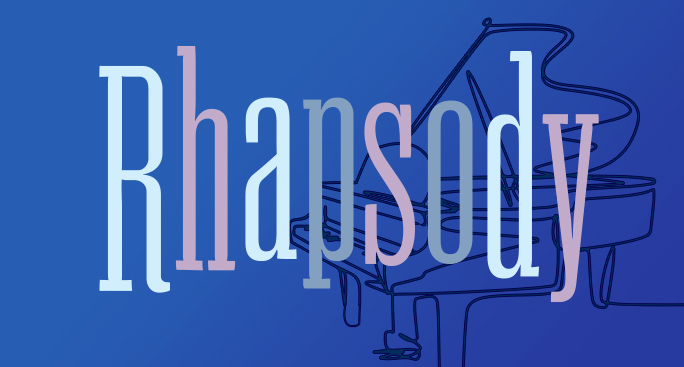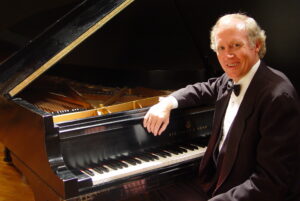Tonight’s concert themes center around a date, a place, and a color.
The Date: 1924
One hundred years ago, in 1924, American composer George Gershwin published Rhapsody in Blue, one of his most recognizable creations and a seminal composition that James Ciment says “defined the Jazz Age.” Gershwin’s piece inaugurated a new era in America’s musical history and established Gershwin’s reputation as an eminent composer.
Tonight, our guest pianist Dr. Joe Chapman will present a piano solo version of “Rhapsody in Blue”, as well as Gershwin’s Three Preludes, and two Gershwin songs.
George Gershwin (1898-1937) was the son of Jewish immigrants from the Eastern European region now known as Ukraine. At age 10 he became interested in music after hearing a friend’s violin recital. He took over the piano his parents had bought for his brother Ira and became an accomplished pianist and songwriter. At age 15 he got a job as a “song plugger” on Tin Pan Alley, earning $15 a week to demo and promote new songs. He published his first song at age 17 and earned a whopping 50 cents. He became very prolific, writing songs (under his name and under pseudonyms) and “recording” them onto piano rolls. His music started to gain popularity and could be heard in vaudeville theaters, nightclubs, and on Broadway.
The origin of Rhapsody in Blue was a commission from Paul Whiteman for a concerto-length jazz composition for a concert celebrating Lincoln’s birthday. Gershwin initially declined, but reconsidered when it was rumored that Whiteman’s archrival was trying to upstage him with a similar event. Gershwin had limited time. On a train ride to Boston, he found his inspiration, as biographer Isaac Goldberg quotes:
It was on the train, with its steely rhythms, its rattle-ty bang, that is so often so stimulating to a composer…. I frequently hear music in the very heart of the noise. And there I suddenly heard—and even saw on paper—the complete construction of the rhapsody, from beginning to end. No new themes came to me, but I worked on the thematic material already in my mind and tried to conceive the composition as a whole. I heard it as a sort of musical kaleidoscope of America, of our vast melting pot, of our unduplicated national pep, of our metropolitan madness. By the time I reached Boston I had a definite plot of the piece, as distinguished from its actual substance.
The 1924 composition of Rhapsody in Blue demonstrated ambition beyond shorter songs and revealed a trajectory beyond the popular and musical theater genres. He went to Paris looking for a composition teacher, approaching well-known figures such as Nadia Boulanger and Maurice Ravel. They recognized Gershwin’s unique talent and his blending of classical and jazz styles. They refused to take him as a student, afraid that their instruction might somehow get in the way of the natural fusion of styles that characterized Gershwin’s work. In Ravel’s rejection letter he aptly said, “Why become a second-rate Ravel when you’re already a first-rate Gershwin?”
Gershwin first performed his Three Preludes in New York City in 1926. His initial idea was to compose a prelude set entitled “Melting Pot” featuring 24 Preludes in every major and minor key (a la Bach’s Well Tempered Clavier). He never completed the set, and some sketches ended up as material for other songs and compositions. The published set ended up with three short preludes that, combined, are about 5 minutes in length.
The first Prelude, Allegro ben ritmato e deciso, has a five-note motif that is developed in a Brazilian baiao (syncopated, duple-meter dance) style. While it has a ternary form, it has the freedom and flow of a fantasia, with vast sprinklings of virtuoso elements, techniques, and stylings. The second Prelude, Andante con moto, has a smoldering blues flavor with harmonies that play with the major vs. minor duality of the blues scale. (The vibe of this prelude is similar to that of Micah Blues later in the program.) The third Prelude, Agitato, subtitled “Spanish”, is built on two melodic phrases that are a question and answer. The first phrase is in minor and the answer returns in major, again leaning into the character of the blues scale.
Later in the concert, Joe Chapman presents two familiar Gershwin jazz standards, “I’ve Got Rhythm” and “Fascinating Rhythm.”
The year 1924 is also the year that Anglo-Irish composer Charles Villiers Stanford died. We remember the 100-year anniversary of his death with one of his most beloved secular compositions, The Blue Bird.
Born in 1852 to a musical and wealthy family, the young Stanford studied at Cambridge and was named organist for Trinity College. He was one of the founders of the Royal College of Music (RCM) at Cambridge, and he was a Music Professor there from 1887 until his death. A fine composer in his own right, his popularity tends to be overshadowed by that of his students, including Herbert Howells, John Ireland, Samuel Coleridge-Taylor, Gustav Holst, and Ralph Vaughan Williams.
Stanford composed about 200 works, including seven symphonies, around 40 choral works, nine operas, 11 concertos and 28 chamber works, as well as songs, piano pieces, incidental music, and organ works. While much of his music is rarely performed in concerts, many of his church compositions remain as standards of Anglican service music.
The Blue Bird is a partsong in two verses, describing a bird soaring over a mirrored lake. The lower voices provide a regular, harmonic underlay for the soprano solo which paints the picture in contrasting rhythms and with a climactic melody that swells to a high A-flat at its peak.
The Place: Blue Ridge Mountains
The Blue Ridge Mountains stretch from southern Pennsylvania all the way to north central Georgia, including the area near Dr. Joe Chapman’s school, the University of North Georgia, in Dahlonega. The Blue Ridge Mountains are known for having a bluish color when seen from a distance. The “blue” in Blue Ridge comes from the isoprene released into the atmosphere from the trees along the mountain range. This contributes to the characteristic blue haze on the mountains and their perceived color.
Elaine Hagenberg composed The Blue Ridge for a Pennsylvania Music Educators Association district conference in 2019. Dr. Ryan Beeken, the conductor of the premier wrote:
This new piece offers a glimpse of a hushed evening I witnessed in the Blue Ridge Mountains with the gentle ascent and descent of the mountains’ silhouette against the sky. I hope the poetry and music bring you a moment of tranquil reflection as we prepare to begin a new year.
The poetry emerges from a gentle “oo” introduction, just as the majestic mountains become visible through the morning fog as the sun rises. The composition has a grand arch, rising to a dynamic climax (“…like the wash of waves”) before settling back into the gentle haze (“send me dreams”).
One portion of the Blue Ridge Mountain Range is a region known as the Great Smoky Mountains. Famously located there, in Pigeon Forge, Tennessee, is Dollywood, a collection of parks and resorts named after actor and musical artist Dolly Parton.
Dolly Parton’s song Light of a Clear, Blue Morning calls to mind the sunrise over the mountains. Perhaps it is not too surprising that this is the first time Griffin Choral Arts has performed an arrangement of a Dolly Parton song! Craig Hella Johnson’s wonderful arrangement has been programmed by high school, college, and professional choirs all over the world (including the arranger’s own professional chorus, Conspirare) because it captures the hope and optimism that “everything’s gonna be alright” in a very powerful way.
Dolly Parton began her career performing and touring with country legend Porter Wagoner. Although the duo experienced overwhelming success, Dolly felt limited and stuck in a decidedly Country/Western path. So, in 1974 she left Wagoner’s band to pursue writing and singing more mainstream kinds of music. Wagoner was not happy about Dolly’s departure, and he responded with lawsuits that left both artists wounded and frustrated. Dolly called Light of a Clear, Blue Morning her “song of deliverance.” Biographer Alanna Nash wrote that the song was written as Parton “felt the figurative clouds lifting, as the fruits of her sacrifices of the previous few years were becoming apparent.” The song was originally released in 1977, and it was included on a new Dolly Parton album in 2003 entitled “For God and Country.”
The color: Blue
All of the choral works on tonight’s program contain the word “Blue” in the titles.
Leroy Anderson’s Blue Tango refers to “a world of blue” but does not really explain what that world might be. Perhaps it is a reference to carefree “blue skies.” Regardless, it was Leroy Anderson’s first big hit in 1952 with the instrumental version reaching #1 and spending 15 weeks on the Hit Parade. It was the first such song to sell over a million copies. The tango is a dance style usually attributed to Argentina. Tangos have a firm 4/4 meter and melodies that are usually mysterious and somewhat seductive. When the 4-hand piano accompaniment begins, you will likely recognize the tune, even if you don’t immediately recognize the title. Like Leroy Anderson’s other familiar works (Sleigh Ride, Bugler’s Holiday, and The Typewriter), Blue Tango has a highly contagious and memorable melody.
Kyle Pederson’s Micah Blues hearkens back to the style of the second Gershwin Prelude. It begins with a smoky introduction for piano and saxophone. The tenor soloist introduces the familiar text, adapted from Micah 6:8: “Do justice, love kindness, walk humbly with our God.” The choir provides support to the soloist and eventually emerges with the theme before the instruments take off into an improvisational middle section. The music swells into a romping, energetic polyphony before a sudden stop, finishing with a rubato, bluesy conclusion.


